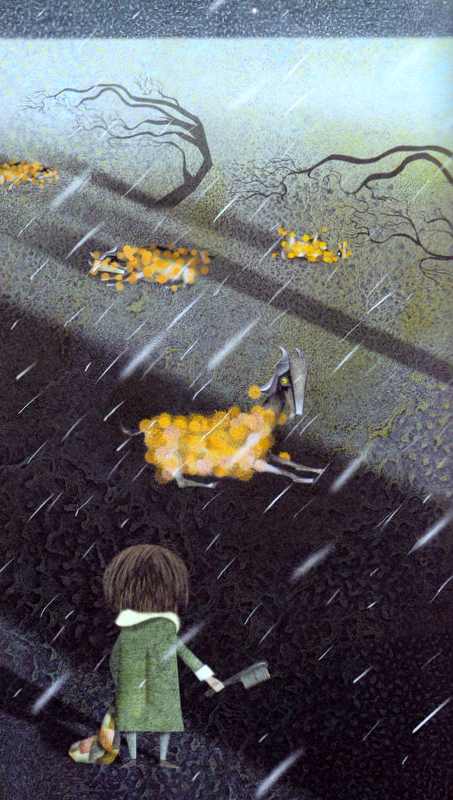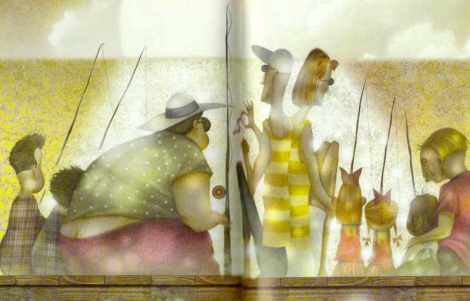I originally posted this review on September 20, 2012. George Saunders’s latest book, Tenth of December, has been getting quite a lot of well deserved attention so I wanted to take this opportunity to remind readers of this lovely gem he wrote for children.
The Very Persistent Gappers of Frip
Middle Reader
Ages 5-12
By George Saunders
Illustrated by Lane Smith
84 pages
Villard Books
2000
Persistent: continuing firmly or obstinately in a course of action in spite of difficulty or opposition
Gappers: baseball sized, bright orange creatures with multiple eyes
Frip: a small, seaside town consisting of three leaning shacks
George Saunders received a MacArthur Fellowship (aka, a genius grant) in 2006 and is generally an adult writer by trade. His short stories and essays have appeared in The New Yorker, GQ, Harper’s and McSweeney’s, to name a few. I’ve not acquainted myself with his other works, but I adore this book. Saunders has a gift for weaving a tale while dropping in bits and pieces that all come together to form a delightful story. And an ideal story for the illustration style of Lane Smith.
If you know children’s books, you know Lane Smith. He is the illustrator of The True Story of the Three Little Pigs, The Stinky Cheese Man and Other Fairly Stupid Tales, The Time Warp Trio Series, Grandpa Green, It’s a Book, and many, many others. His style is unmistakable, even with all the copycats out there; no one comes close to Lane. He combines a variety of media to create the most engaging, enticing, quirky, interesting and utterly perfect art. I adore his books. All of them.
If you don’t know Lane Smith’s books, a whole new world is about to open up for you.
The Very Persistent Gappers of Frip is a cautionary tale; one which demonstrates that you should not take joy in another’s misfortune, for you may someday find yourself in a similar position.
Frip’s entire population is made up of three families—Capable, and her recently widowed father, the Romos and the Ronsens—and though they all live by the sea, their livelihood is reliant on their goats, since goats make milk that the families can sell.
Gappers, those meddlesome creatures, love goats more than anything else. They attach themselves to the goats, and then proceed to emit a high-pitched squeal of pleasure. This is troublesome to the goats; it causes them lose sleep, lose weight, and eventually, stop giving milk.
It is the job of the children to brush the gappers off their family’s goats, gather the gappers in sacks, and empty the sacks into the sea. It takes the gappers three hours to crawl out of the ocean, up the cliff and back onto the goats. Therefore, the children must perform this task eight times a day. Every day.
Capable’s house is closest to the sea so the gappers always reach her goats first. When one marginally smarter gapper realizes that they can get all the goats they need from this one family, things become unbalanced.
The Romos and Ronsens couldn’t be more pleased to be relieved of their brushing duties and are all too vocal about it. Now Capable is doing the work of three families all by herself and she cannot keep up. Despite her father’s wishes, Capable asks the neighbors for help. Not only are they not willing to help, but they also blame Capable for bringing this plague upon herself! In fact, they’ve moved their houses farther away from hers so as not to “catch” whatever it is she has that brought all the gappers to her yard, instead of spreading out over all three yards.
Capable can take no more. Though her neighbors tell her she should work harder, smarter and more efficiently than physically possible, she rounds up all her goats and sells them in a nearby town. Capable knows she tried her best and her best hadn’t worked. She decides to take up fishing; something that no one in Frip has done for quite a long time.
The gappers are forced to move onto the next family’s goats, those that belong to the Romos. Evidently, it had not occurred to the other families that the gappers would be back to taunt their goats once Capable’s goats were gone. With the tables turned, the Romos now look to the Ronsens for help. The Ronsens, clearly not anticipating what is to come, refuse to help. After a series of ridiculous (yet true to life) strategies to rid themselves of gappers, the Romos and the Ronsens find themselves in dire circumstances. Capable, initially pleased to see the families get their comeuppance, takes pity and invites them for dinner.
Finally seeing the wisdom of Capable’s ways, the Romos and the Ronsens decide to sell their goats and take up fishing. And things in this small seaside town get a little better.
But what of the gappers? With the all the goats gone they need to find a new object of devotion to which they can attach themselves and emit their loving shrieks. They soon find something perfectly suitable to their needs, creating the scene of one of my favorite book endings ever.
















You must be logged in to post a comment.